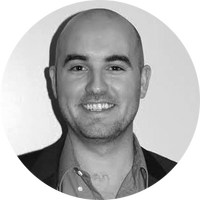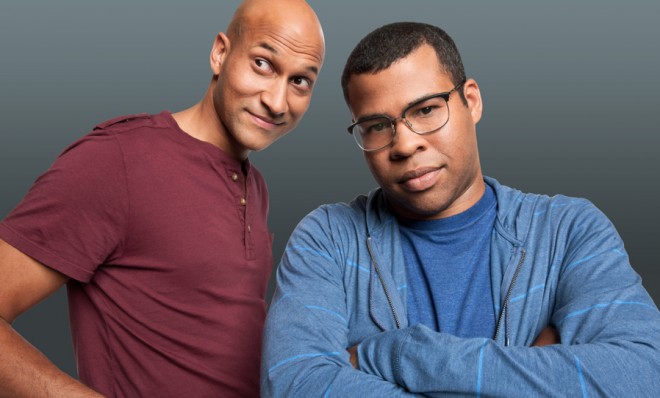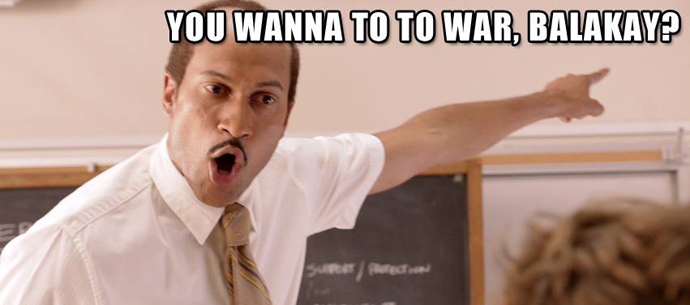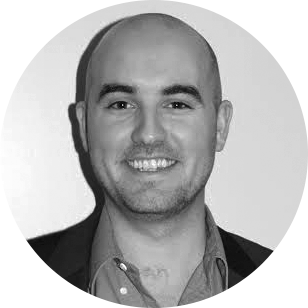Interview: Key & Peele explain how they created 'Substitute Teacher'
The stars of Comedy Central's Key & Peele talk about their creative process, offer up the student names that didn't make the final cut, and more


Key & Peele, which premiered its third season on Comedy Central last week, has gradually grown into the sharpest and most consistent sketch comedy show on television. In a wide range of sketches, the duo tackle everything from the Trayvon Martin case to hip-hop hype men to Les Miserables — and that's just in a single episode.
The show's far-ranging, unmistakable comic sensibility comes from creators and stars Keegan-Michael Key and Jordan Peele — but how does one of their sketches actually come together? I recently spoke to Keegan-Michael Key and Jordan Peele about the origins of "Substitute Teacher" — one of their most popular sketches ever, and one they revisited in last week's season premiere — to get a better understanding of their creative process:

The original "Substitute Teacher" sketch is your most-viewed YouTube video ever, with more than 33 million views and counting. How did the idea originally come about?
The Week
Escape your echo chamber. Get the facts behind the news, plus analysis from multiple perspectives.

Sign up for The Week's Free Newsletters
From our morning news briefing to a weekly Good News Newsletter, get the best of The Week delivered directly to your inbox.
From our morning news briefing to a weekly Good News Newsletter, get the best of The Week delivered directly to your inbox.
Key: It was basically just the idea of a guy from the inner city who was subbing in an all-white classroom. That was literally the premise of the sketch.
Peele: One of our writers brought the original idea to us, and Keegan immediately starting embodying Mr. Garvey, the substitute teacher character. It was one of those things where it just a great nugget for a sketch. Once that first draft was down, it came to a community vibe; as a collective, we came up with what names were going to work, deciding how Keegan was going to heighten Mr. Garvey's physicality.
It sounds like you both knew, almost instantly, that Keegan would be playing the character. Is it always that easy?
P: Keegan's writing process is really on his feet. He's the master of using improv as a writer, and embodying the character — becomes the character — as we're writing it. It gives us the chance to say, "Oh, that's a great idea." And the writer can offer him back something. It's that sort of give and take. I'm more of a fingers on the… typewriter? [laughs] Fingers on the keys type of guy. And Keegan is more of a feet on the ground type of guy.
A free daily email with the biggest news stories of the day – and the best features from TheWeek.com
K: In our pitch sessions — when ideas are forming — it could be me, or Jordan, or an executive producer, or one of the other writers adding lines to the concept. Usually, Jordan or I will hook into one of those lines, and then you can see the writer go, "This is good. You can see that Jordan has the voice for it." Or, "Keegan has the voice for it."
Once you had the core concept for the sketch down, how did you decide on Mr. Garvey's appearance? It's such a distinctive look.
K: I wanted him to look a little high-and-tight, you know? As if he had been in the military. I didn't want him to actually be from the military — I just wanted him to have that sense. He had spent 20 years disciplining these children in the inner city to no end — so he has this kind of hard, rigid sensibility about him, and I wanted that to be in his dress. He's wearing a short-sleeve shirt and a really ratty, terrible tie, and has a receding hairline, to give him some age. I wanted his tie to be short, but not too short. And then his mustache, to me, looked like a mustache that a substitute teacher might have. We also gave me a little bit of age around my eyes and under my nose. Just to give him a spice of "haggardness."

The sketch hinges on having the perfect names for Mr. Garvey to mispronounce: Jacqueline [pronounced Jay-QUEL-inn], Blake [pronounced Bell-AWK-ay], Aaron [pronounced Ay-Ay-Ron]. How did you decide on those specific names? Were there any that didn't make the cut?
K: There were several. The one that comes to my mind is Jonathan [pronounced Joe-NAY-Thin].
P: We went through a few names to get to Timothy [pronounced Tim-OH-Thee].
K: Jonathan was in the running for a long time. There was David [pronounced Dah-Veed], which didn't work at all. We went through a few. I think Denise [pronounced DEE-Nice] was always in there.
P: Aaron and Blake came through because they're the names of very white friends of mine from when I was a kid. That was another thing. The best names for this are names that are really white names.
K: Super white names.
P: It became a feeding frenzy for the writers at a certain point.
Let's talk about the sequel to the original "Substitute Teacher" sketch, which aired in last week's premiere. How did you decide to bring Mr. Garvey back for another round?
P: We wanted to bring that character back because people fell in love with him. But when you bring someone back, you want to make sure it's not just a cookie-cutter, by-the-numbers version of the original sketch, where you have the exact same gag with different names. It was very, very difficult for us to figure out how to do it. [The concept] really goes back to the difference between the cultures of an inner city school and a more privileged school in the suburbs.
K: What advantages would that school have that inner city schools don't get?
P: It was really in the final hour of planning the new season [that we came up with the idea]. We had been trying to figure it out. We were searching for it through the entire writing process. There were a couple of different ways we were thinking about going about it — one of which we almost did — but this seemed like the right way to do it.
What was the idea you didn't use?
K: The idea for the majority of the writing process was that Mr. Garvey was teaching a Spanish class, but his experience in Mexico — when he was younger, in the army — was very harrowing. So the only Spanish he knows is Spanish like "Help me, I'm kidnapped!" or "How much for that prostitute?" That kind of stuff. It wasn't functional Spanish that anyone would use — but the kids would have to repeat after him. Some of it was interesting, but some of it was, "Well, is that Mr. Garvey? Is that really his character? Or is this a different teacher?" There were some structural issues we had.
P: Part of it was that it came off differently than what the joy of the original scene was. The joy of the original scene is that he doesn't trust them. He's there, one eye on the blackboard and one eye on the students.
K: [affects Mr. Garvey voice] "I'm not going to let them pull one over on me!"
P: That's his motivation. For Mr. Garvey, the names are secondary.
Keegan: Was it difficult to conjure up Mr. Garvey's character again?
K: No. He's a character that I feel very comfortable playing. He's kind of… how can I put it… a relative of a character I used to play. I love characters like that, who are blustery, because I'm anything but blustery in real life. [laughs] So it's fun to play that character, and it was fun channeling him again. It has that lovely feeling, like putting on a comfortable pair of shoes.
You mentioned using improv as a part of your process earlier. Was that also true for the sequel?
K: There was a lot of improv, but I can't think of how much got in this time. The one piece that really made it in that first one was "insubordinate and churlish." That was improvised. In the second piece, there's a small little fragment. With improv, you always want to make sure it's enhancing what's happening — or if it's possible, bring a piece to a new plane while you're doing it. What you don't want it to do is go completely off-track. Everybody on the crew is having a really great time, and you're having a really great time, but it's a bigger challenge in the end.
Jordan: You have an unusually minor role in the Mr. Garvey sketches — what essentially amounts to a cameo at the very end of each one.
P: It's one of the few sketches I get to kind of be in the producer's chair more exclusively. It's great.
K: He would just run in when we needed him, then run back to the monitor. "It's time to plug Jordan in."
How were you able to reassemble the same cast of kids again?
K: They were happy to do it. And the environment on set was lovely — like it was a little class reunion. They loved seeing each other. A couple of them hang out sometimes. We tried to make it a kind of festive, fun atmosphere. I had to be stern at the same time, which was interesting. Stern, but festive. When you look at the extras in the second one, they're really terrific. Really great looks — people behind them, aghast at his behavior. But those four [Jacqueline, Blake, Denise, Aaron]. They're really terrific. It makes my job easier.
At what point in the process did you realize how big the "Substitute Teacher" sketch was going to be?
P: We did not realize [while we were making it]. We knew it was going to be a hit, but we didn't realize how much it would really speak to the educators' community. We got a lot of feedback that people were showing it in classes.
K: Of all the sketches we were putting [on YouTube] last year, that was originally not one of the ones that was going to be online. And then we did, and it's like, "Whoa!"
P: It's a perfect storm. If you know somebody whose name is in it, you're going to send it to that person. Anyone who's ever experienced something like that. It's taught us a lot about how the internet works.
K: It's funny, you look back on it now and go, of course. Everybody goes to school. Everybody can identify with a substitute teacher. That's a thing everybody's had. But you don't think about it when you're writing the sketch — or certainly, we didn't think about it then.
P: I wasn't thinking about it.
K: But like Jordan said, now you go, "Oh, I see." There were a couple of months where every week I'd have a new epiphany. "Oh, here's another reason why this one is popular." It just started to make sense.
Given his popularity, do you think a third sketch featuring Mr. Garvey is in the cards?
K: [sigh] I don't know. You know, if we hadn't landed on what we thought was the right sequel, we probably wouldn't have done it.
P: We want to have a reason to visit a character besides the fact that people want more. We don't have as much time as other sketch shows. There aren't as many episodes in a season, or as much time in one episode. But I think we'll figure it out.
K: Yeah, I think we'll have an idea. One thing that Mr. Garvey offers us, as a sketch show, is something with a little bit of familiarity. It's hard to hook people into actually watching the show, and one of the things we can offer is, "If you watch this show, Key & Peele, you'll see your favorite character."
Scott Meslow is the entertainment editor for TheWeek.com. He has written about film and television at publications including The Atlantic, POLITICO Magazine, and Vulture.
-
 US citizens are carrying passports amid ICE fears
US citizens are carrying passports amid ICE fearsThe Explainer ‘You do what you have to do to avoid problems,’ one person told The Guardian
-
 All roads to Ukraine-Russia peace run through Donetsk
All roads to Ukraine-Russia peace run through DonetskIN THE SPOTLIGHT Volodymyr Zelenskyy is floating a major concession on one of the thorniest issues in the complex negotiations between Ukraine and Russia
-
 Why is Trump killing off clean energy?
Why is Trump killing off clean energy?Today's Big Question The president halts offshore wind farm construction
